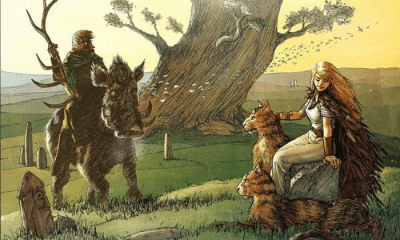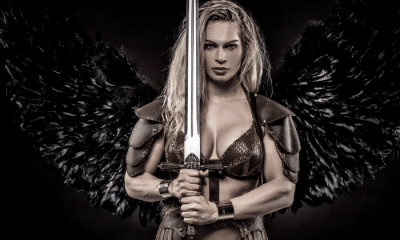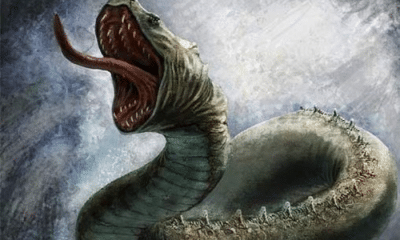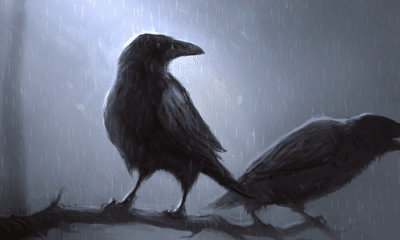Norse
Who is Mímir in Norse Mythology?
The Norse guardian of secret wisdom might have lost his head, but that didn’t keep him from sharing what he knew! Here is everything you need to know about Mímir, the headless Norse god of knowledge.
The Norse god of knowledge took an unusual form. He had been beheaded in the war between the Aesir and Vanir gods, but Odin had preserved his head.
Mímir the disembodied god watched over one of the wells at the roots of Yggdrasil. The water of the well carried his vast knowledge.
One of the most well-known stories involving Mímir shows what Odin was willing to do to gain the knowledge of the well. The chief of the gods was willing to pull out one of his own eyes to learn the secrets of Mímir.
So what kind of knowledge did Mímir hold that Odin was willing to partially blind himself for it?
The Origins of Mímir
It is unclear from written sources whether Mímir was one of the Aesir gods or another type of being. It is known, however, that he sided with the Aesir during the war of the gods.
When the gods fought one another, Mímir was beheaded by the Vanir to keep him from using his knowledge to aid their enemies. Odin found Mímir’s head on the banks of a river.
In another version of the story, Mímir was given to the Vanir in an exchange of hostages. The Vanir also took Hoenir, who they made their chief because of his strength and beauty.
Hoenir was not particularly wise, however. When the new chief of the Vanir was with others and asked Mímir what course of action he should take, he was always told, “Let others decide.”
Hoenir believed that the Vanir had been misled in regards to their hostage’s wisdom, when Mímir was actually making an accurate assessment of his leadership skills. In frustration, and perhaps to protect his new position among the Vanir, Hoenir beheaded his hostage and set his head back to Odin.
The Head of Wisdom
Although Mímir had been beheaded, he did not die.
Odin preserved Mímir’s head with embalming herbs and magic spells. Mímir had no body, but was still able to share the contents of his mind with others.
The chief of the Aesir carried the severed head with him nearly everywhere he went. Odin could consult Mímir at any time for his sage advice.
Through Mímir’s constant influence, Odin became wiser himself. Each day the head imparted new lessons and gave him more insight into the world.
Odin no longer felt the need to carry the head with him. He would consult Mímir when needed, but in most matters could trust his own knowledge.
According to some accounts, Odin placed Mímir beside an existing well. In other versions of the story, the head created a well wherever it was set.
This well became Mímir’s home and an important site in Norse mythology.
The Well of Mímir
Mímir’s well, known as Mímisbrunnr in Old Norse, was said to be beneath one of the three largest roots of Yggdrasil, the World Tree.
Where exactly this was, however, depended upon the source.
Much of our knowledge of Norse mythology comes from Snorri Sturluson’s Prose Edda. Although Sturluson wrote in the 13th century, well after Scandinavia had been converted to the Christian faith, his works are the most reliable source for most myths.
Scholars are cautious when reading The Prose Edda, however, because it was written at a time when Christian and Latin influence was stronger than belief in the ancient gods.
According to Snorri Sturluson, Mímir’s Well was in Jötunheim. He wrote:
Under the root [of Yggdrasil] that goes to the frost giants is the Well of Mimir. Wisdom and Intelligence are hidden there, and Mimir is the name of the well’s owner. He is full of wisdom because he drinks of the well from the Gjallarhorn.
-Snorri Sturluson, The Prose Edda
Others, however, claimed that Odin had placed the head in a hidden place in Asgard and created the well there, probably within his own hall of Valhalla. This allowed him to consult Mímir in private and prevented anyone else from trying to steal his knowledge.
Some interpretations hold that Mímisbrunnr is the same as Urðarbrunnr, the Well of Urd. This was the well by which the Norns wrote out fate and the site of the daily counsel of the gods.
The well itself held Mímir’s great knowledge and a single sip would give someone unknown insight into the mysteries of the Nine Worlds. The Prose Edda said that Mímir himself drank from the well to continuously gain more wisdom, although earlier sources implied that he was the source of that power.
Odin continued to visit the well to seek Mímir’s guidance when needed. The chief of the Aesir was always hungry for knowledge, however, and what he truly wished for was a drink of the water.
Odin’s Search for Knowledge
One of Odin’s defining characteristics in Norse mythology was his pursuit of hidden knowledge and secrets. With this goal in mind, the well of Mímir was an irresistible source of power.
Mímir said that a great sacrifice was needed to drink from his well. Odin plucked out his own right eye and threw it into the well, offering it in exchange for knowledge.
Mímir accepted this offering and allowed Odin to take Gjallarhorn, his great drinking horn, and fill it from the well. Odin afterward was noted for having only one eye, having sacrificed the other for knowledge.
The truths Odin learned by drinking from the well of Mímir are never disclosed in any written sources, likely because they remained known only to the two of them.
The sacrifice of his eye was not the only time Odin went to great lengths to seek our wisdom, however. Others included:
- Consulting the Völva – Odin traveled to the land of the dead to consult a deceased shaman woman, or Völva, who prophesied the end of the world at Ragnarök. His desire to know more about the fate of the gods, particularly his son Baldr, is what led him to Mímir’s Well.
- The Sacrifice on Yggdrasil – Odin sacrificed himself, hanging from the branches of Yggdrasil for nine days and nights without food or water. He learned nine secret forms of wisdom, including how to use magical runes.
- Stealing the Mead of Poetry – Made from the blood of Kvasir, the Mead of Poetry inspired great scholarly and poetic achievement. Odin stole the mead by seducing the giantess that guarded it and flew away with it in the form of an eagle.
- His Use of Animal Familiars – Odin’s animal companions, particularly the ravens Hugin and Munin, relayed information to him about current events around the world.
In many of these stories, including that of the Well of Mímir, Odin is willing to make great personal sacrifices to obtain knowledge. The lesson to the Norse people was that wisdom could be difficult to obtain, but was worth the price.
Unfortunately, one thing Odin could never learn was how to avoid Fate.
The All-Father sought many forms of knowledge, particularly the signs and events of what would happen when the gods fought at Ragnarök.
Although he had advance knowledge of what would happen when the battle began, he always tried to learn more. When Heimdall’s horn sounds to begin the last battle of the gods, The Prose Edda says that Odin’s first act will be to race to the Well of Mímir to try to learn more about what is to come.
The Meaning of Mímir
Odin will likely glean little insight into the future from the water of Mímir’s well, however. The disembodied head is said to have the most information about the secrets of the past.
The name Mímir is almost certainly derived from an Indo-European root word for “memory.” In fact, this English word contains the same linguistic root.
Translated into English, his name is usually styled as The Rememberer.
While the Well of Urd contains the plans of Fate, the Well of Mímir contains the knowledge of past events. His power is not the ability to foretell what will happen in the future, but to remember the lessons and secrets of the past.
In the context of Norse culture, Mímir thus represents the collective wisdom of the ancestors.
The Norse people put great stock in their ancestry, keeping detailed lists of the names and exploits of their forefathers. This reverence probably grew out of an ancient practice of ancestor worship, and while the Norse people did not believe their forebearers to be literal gods they still believed that they could be called upon.
The people of the past were believed to have possessed great wisdom. In some legends, they were in closer contact with the gods in life, and if they could be called upon after death the most revered of them would be in Valhalla at Odin’s side.
Mímir personifies this reverence for the past and the importance of learning from history. His knowledge was the collective wisdom of the past, including the secrets that had been forgotten by people of later eras.
The Family Relationship
According to some scholars, there is a possibility that Mímir gave Odin another source of knowledge.
Odin’s mother was a jötun named Bestla. Her father was Bolthorn.
In one poem from the Viking Age, Odin describes what happened after he stole the Mead of Poetry from Gunnlöð, its keeper’s daughter. He says he learned nine magical songs “from the famed son of Bolthorn, Bestla’s sire.”
Bolthorn’s son would be Bestla’s brother or half-brother, and thus Odin’s uncle. Several scholars, from the late 19th century through the modern era, have theorized that this unnamed jötun may have been Mímir.
This familial relationship would also be logical in the context of the story of the hostage exchange between the Aenir of the Vanir. Njöðr, the chief of the Vanir, sent his son Freyr, so in an even exchange Odin would have been expected to send a close relative to the Vanir as well.
Because Norse mythology is less well-preserved than that of Greece or Egypt, family relationships and motivations are often less clear. If Mímir can be interpreted as Odin’s uncle, this gives additional context for why he was given as a hostage and why he so often helped the one-eyed god.
If Mímir was the source of Odin’s nine magical songs, it can be assumed that they were a form of lost knowledge because of his role as the god of memory. And if he was, as some scholars believe, Odin’s nephew, the songs would be exactly the type of ancestral wisdom the Norse people valued.
Mímir and the Well of Knowledge
Mímir is the Norse god or guardian of knowledge, sometimes called The Rememberer. He watches over his well, Mímisbrunnr, at the base of one of the World Tree’s massive roots.
Mímir was beheaded in the war between the two tribes of gods, the Aesir and the Vanir. His body was lost, but Odin preserved his head with both herbs and spells.
Odin often consulted Mímir for honest and wise advice. What the inquisitive chief of the Aesir truly desired, however, was to drink fro the Well of Mímir and absorb the knowledge that its water held.
Mímir, however, told Odin that such knowledge required a great sacrifice. Odin plucked out his own right eye and permanently traded it for access to Mímir’s secrets.
Even after drinking from the well, however, Odin still sought the advice of Mímir. It was said that when Ragnarök begins, Odin will run to meet with Mímir in an attempt to learn more in the world’s final hours.
Mímir’s knowledge was likely rooted in the past, based on the meaning behind his name. As the god of remembrance, he personified the lost secrets of the past and the forgotten wisdom of the Norse people’s ancestors.
There is also a chance that this ancestry is reflected in his relationship with Odin. Some scholars believe that Mímir may be the unnamed brother of Odin’s mother, Bestla, who taught him nine magical songs after he stole the Mead of Poetry.









